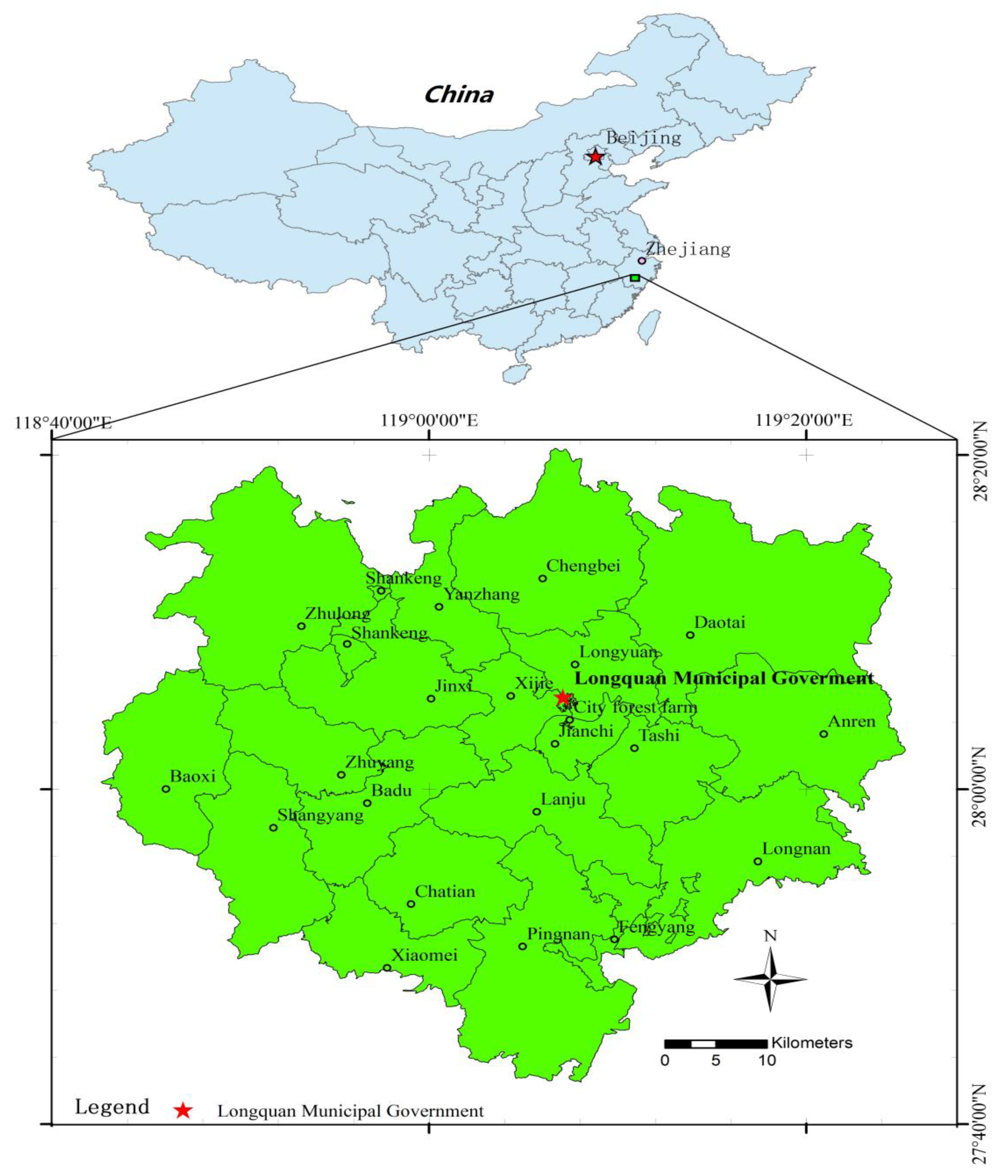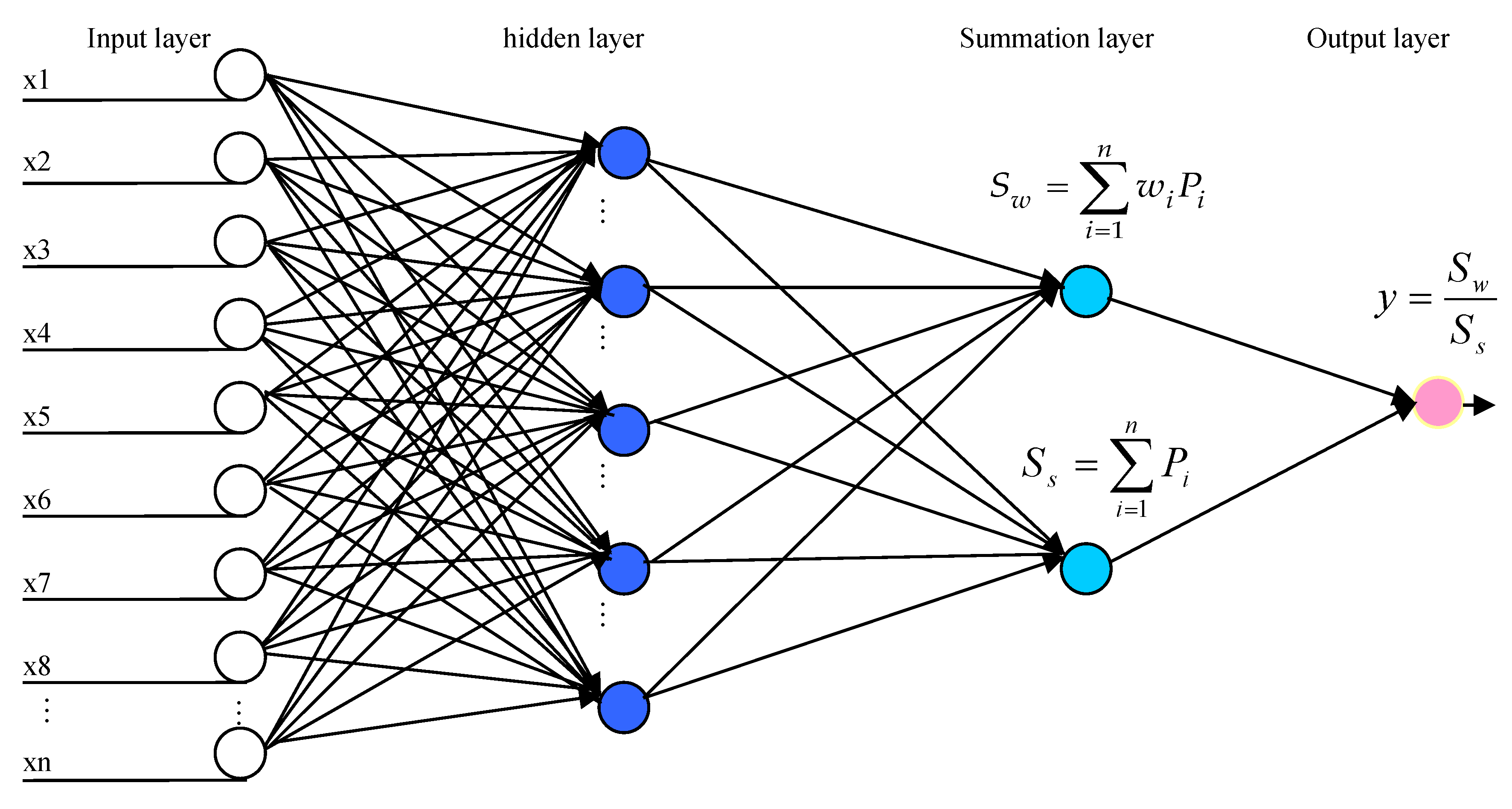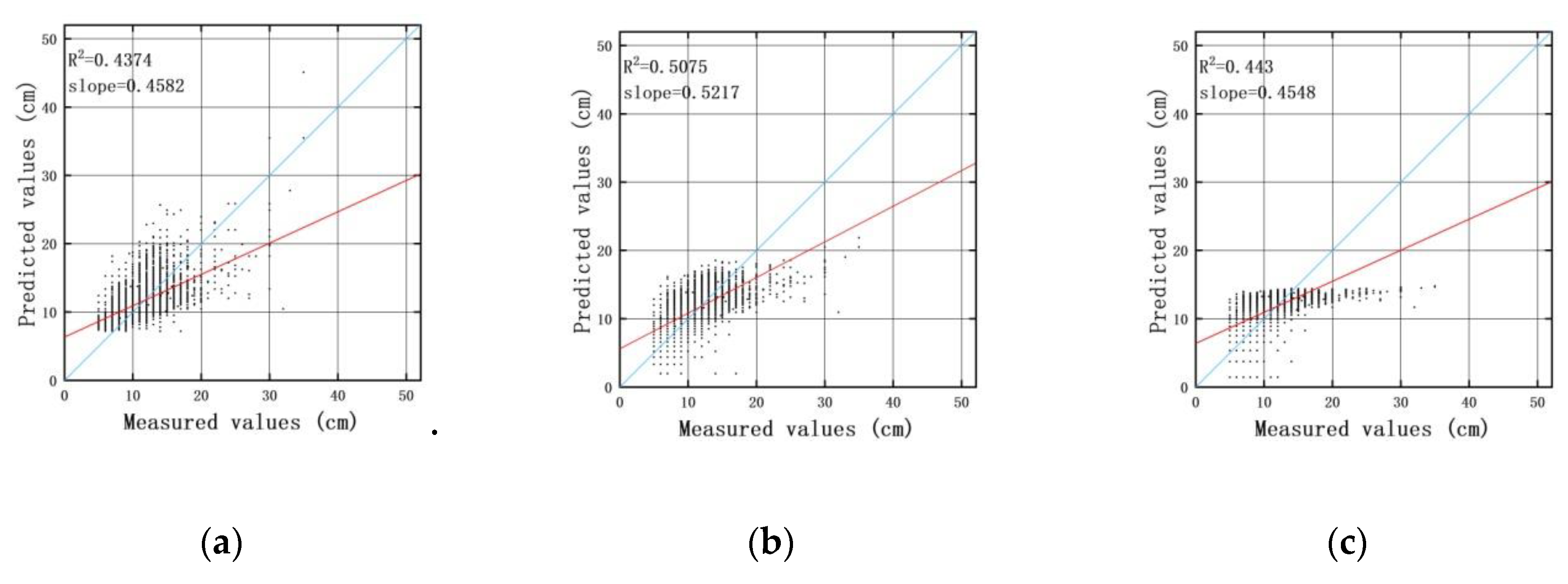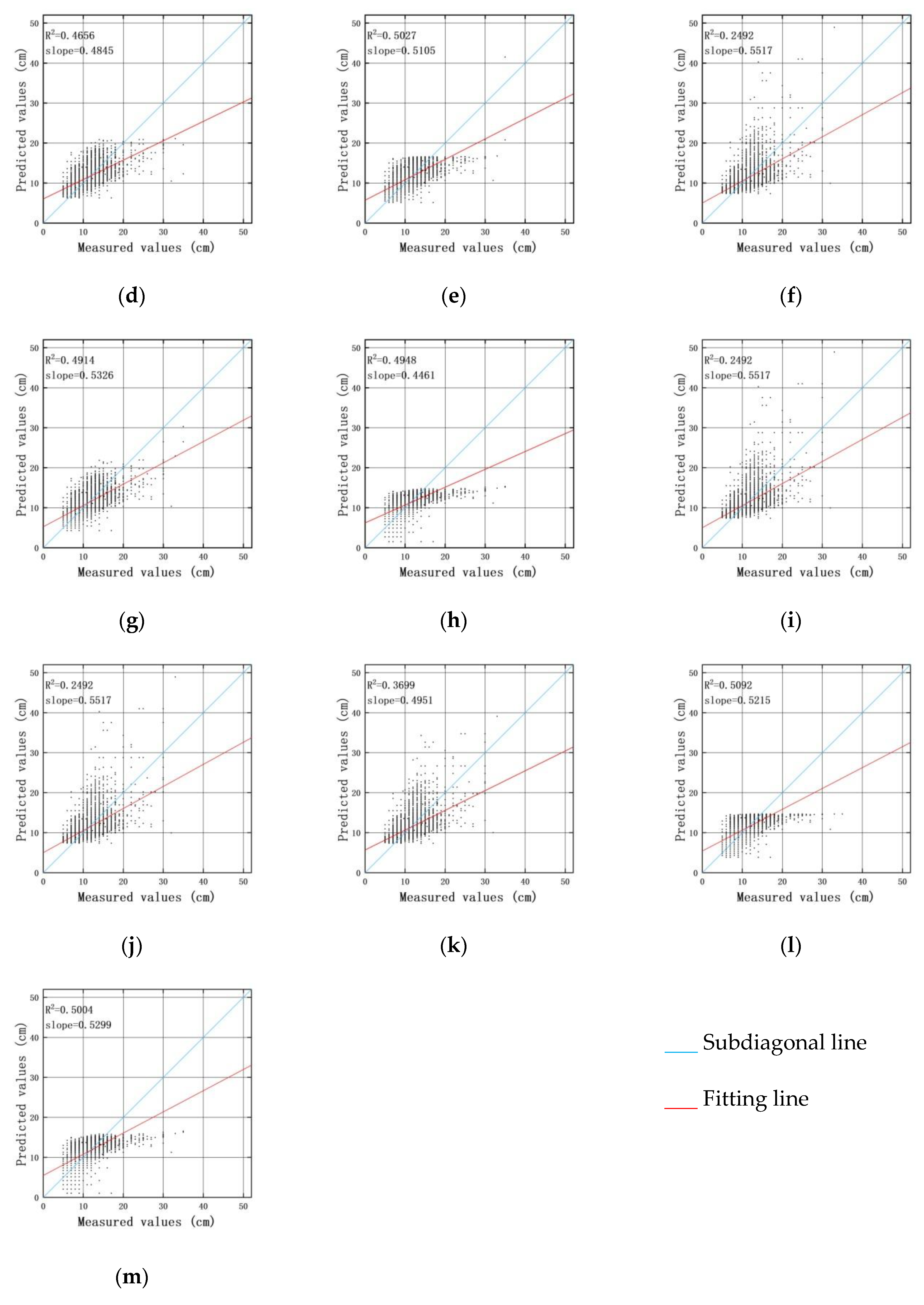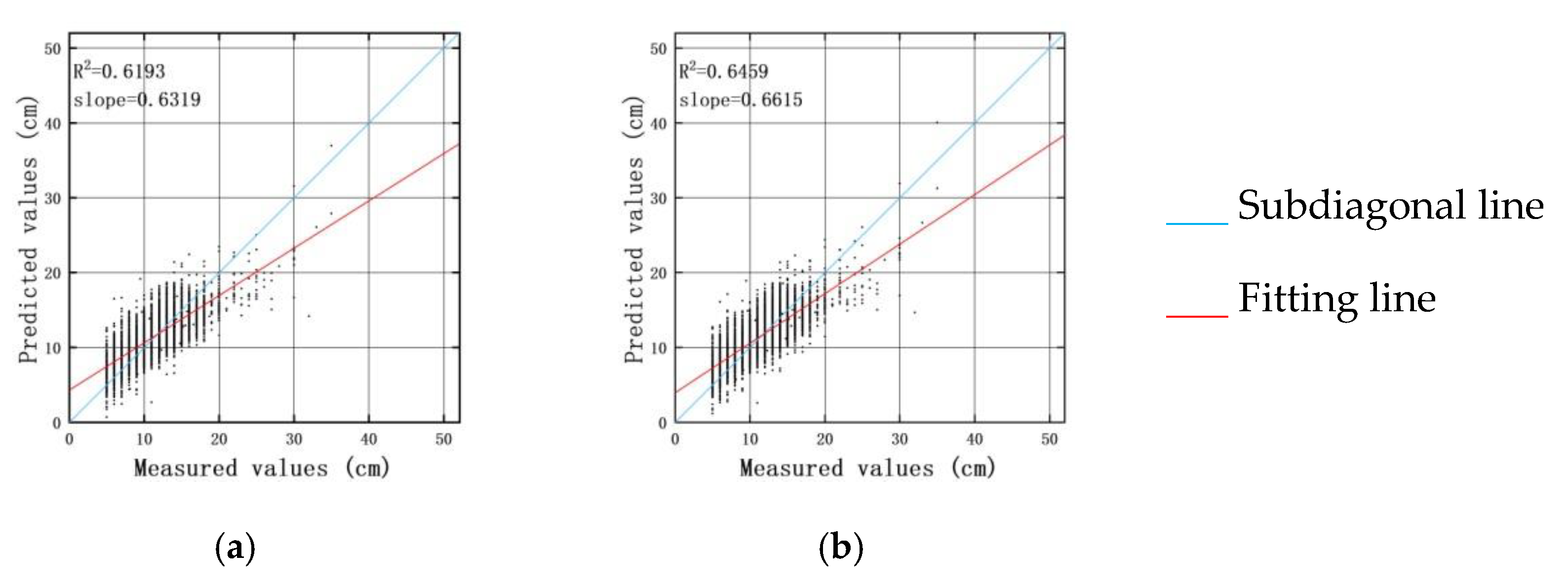1. Introduction
In forest monitoring, the diameter at breast height (DBH) is the diameter of a cross-section of a tree trunk 1.3 m above the ground. The DBH is an important factor used to estimate important forestry indices like forest growing stock, basal area, biomass, and carbon stock. The traditional DBH ground surveys effectively provide objective and reliable monitoring and managing information for forest resources [
1,
2,
3,
4], but they are time-consuming, labor-intensive, expensive, and hard to implement, particularly in mountainous and forest areas [
4].
The establishment of DBH prediction models has mainly been based on stand growth models. Three kinds of models are frequently used: Empirical models, process models, and hybrid models [
5]. Empirical models require some biological factors such as tree height, age, and crown width as independent variable sets, and introduce some regression estimation methods, such as curve, Gompertz, Schumacher, or Richards models, in estimating DBH [
6,
7,
8,
9,
10]. Although their construction is intuitive and simple, the variability of the empirical relationship between the dependent and independent variables means the empirical models are less adaptable. By introducing physiological and ecological factors, such as climate, precipitation, and soil, the process models improve the ability to simulate stand growth [
11]. The inclusion of many physiological and ecological factors produces highly complex and inflexible process models, which leads to difficulties in meeting the actual requirements. In combining empirical models and process models, hybrid models—which include the linear mixed effect model and the nonlinear mixed effect model—have better estimation accuracy and adaptability. However, the combination further increases the complexity and flexibility of the models.
Artificial neural networks (ANNs) can be effectively used to solve nonlinear problems [
12], such as the prediction of forest growth. To find more effective methods for forest growth estimation, many experts and scholars have introduced ANN models into the field of forestry for the dynamic monitoring of forest resources and the simulation of forest growth process [
13,
14,
15]. Compared with traditional stand growth models, the backpropagation neural network (BP-NN) model provides the best prediction effect to fit and analyze the growth of tree DBH [
16,
17,
18].
Compared with the BP-NN model, the generalized regression neural network (GRNN) model has the advantages of a simpler structure, fewer parameters, a faster prediction speed, and less computational complexity [
19]. Correspondingly, some scholars have used the GRNN model to estimate forest parameters [
20,
21].
Scholars have found that DBH is strongly affected by environmental factors, such as topography, soil, and climate [
22,
23,
24,
25,
26,
27]. Pach et al. showed that at fertile mountain sites and highland forest sites, fir trees reached the highest growing stock [
23]. Li et al. showed that the DBH growth of natural Korean pine forest is affected by topographic factors, particularly the elevation and slope direction [
24]. Ou et al. found that DBH growth is correlated with the slope direction, soil hydrolytic nitrogen, dominant tree height, average tree height, and tree density [
25]. Yu et al. and Wang et al. found that temperature and precipitation affect the DBH growth of larch, spruce, fir, and Tianshan spruce [
26,
27].
The increasing resolution of remote sensing images has provided additional benefits for forest monitoring. Zarco-Tejada et al. showed that the tree height can be obtained by three-dimensional (3D) reconstruction from unmanned aerial vehicle (UAV) images [
28]. Ibanez et al. reported that various forest parameters, with the exception of DBH, can be directly obtained using light detection and ranging (LIDAR) images according to the point cloud characteristics at different forest levels [
29]. Using field data and vegetation index (VI) data derived from Systeme Probatoire d’Observation de la Terre 5 (SPOT-5) satellite images, Muhd-Ekhzarizal et al. used some simple and multilinear regression methods to estimate the aboveground biomass in mangrove forests [
30]. Chrysafis et al. found a strong correlation between the growing stock volume and three indices derived from Sentinel-2 images, i.e., the difference vegetation index (DVI), enhanced vegetation index (EVI), and perpendicular vegetation index (PVI) [
31]. Using ALOS-PALSAR L-band full-polarization data, Chowdhury et al. estimated the forest growing stock volume (GSV) and showed that the GSV at forest stand level in Siberia could be quantified with reasonable accuracy, and that temporal variations of GSV could be better tracked [
2]. Vegetation indices (VIs) reflect the dynamic changes of forests to some extent and are helpful in predicting forest parameters. For example, Mou et al. indicated that the normalized difference vegetation index (NDVI) is most sensitive to changes in the canopy leaf area index and Laurin et al. added NDVI values to aboveground biomass estimations to obtain better results [
32,
33]. Han et al. showed that the vegetation indices from different remote sensing data sources have different separability from ground objects [
34]. Reyadh et al. found that a similar variability in the average derived NDVI from different remote sensing data sources, but the average derived NDVI values were different [
35]. Buheaosier showed that the range of NDVIs is related to the spatial resolution of remote sensing data sources [
36]. However, limited by a lack of human power, high costs, weak endurance capability, and a small communication range, UAV remote sensing and radar remote sensing are still difficult to apply to large-scale forest monitoring [
37,
38]. Furthermore, airborne imagery is easily affected by wind power and terrain, and is vulnerable to air traffic control [
39]. In China, especially in the south regions, the weather is usually changeable, and the terrain is usually complex, hence airborne imageries are still difficult to be applied in large-scale forest monitoring. Therefore, satellite remote sensing images remain the main supplementary data resource for dynamic monitoring of large-scale forest resources in China.
During the estimation or prediction of DBH at the forest stand level, the data from the permanent plots (the basic units of national forest inventory) are frequently chosen to validate the various models [
40,
41]. However, in China, the number of subcompartments is much larger than the number of permanent plots. To reduce the cost of investigating, the estimation of DBH based on subcompartments is more valuable than the methods based on permanent forest plots.
This study focused on the prediction of DBH at the subcompartment’s level in Longquan city. The specific purposes of this paper are to: (1) Ascertain the suitable ecological factors, biological factors and remote sensing factors which have great impact on DBH with a relatively low cost for data-acquisition; (2) explore a more accurate and more generalizable model to predict DBH. The specific steps of this study are as follows: First, using tree age as the only independent variable, 13 kinds of empirical models were established to fit the relationship between the tree age and the DBH of forest subcompartments and predict DBH growth. Second, the independent variables were extended to 19 parameters, including 8 ecological and biological factors (elevation, slope, aspect, soil depth, humus thickness, age of tree, canopy density, and number of stems per hectare), and 11 remote sensing factors (bands 2–7 (B2–B7) from the operational land imager (OLI) sensor of the Landsat-8 satellite, NDVI, ratio vegetation index (RVI), DVI, EVI, and red index (RI)). The correlation analysis method was introduced to reduce the dimensions of the independent variables separately for either the set of ecological and biological factors or the set of remote sensing factors. Lastly, the remaining independent variables were adopted for modeling and prediction of DBH of the forest subcompartments using a multivariate linear regression (MLR) model and GRNN model.
2. Materials and Methods
2.1. Study Area
Longquan (
Figure 1), as a southwest city in Zhejiang province in China, with a total area of 3059 km
2, extends from 118°42′ to 119°25′ E, and 27°42′ to 28°20′ N. Due to its location in a central subtropical monsoon climate zone, the city is warm and humid with abundant rainfall. Longquan is the largest forested city in Zhejiang province, with 265,667 ha of forest resources, 14.56 million cubic meters of forest growing stock, and a forest coverage of 84.2% [
42].
2.2. Research Data
The research data included the inventory data for forest management planning and design, the digital elevation model (DEM), and remote sensing images from Landsat-8 Thematic Mapper (TM). The 2017 inventory data were supplied by the Forestry Bureau of Longquan. The TM and DEM data were both derived from the Geospatial Data Cloud [
43].
Six factors were derived from the inventory data for forest management planning and design, including DBH, soil depth, humus thickness, canopy density, number of stems per hectare, and age of tree. Three factors, elevation, slope, and aspect, were obtained from DEM and 11 factors were derived from the remote sensing images, including B2–B7, NDVI, RVI, DVI, EVI, and RI.
The inventory data, containing 58,910 records of forest subcompartments, were obtained from the Forestry Bureau of Longquan in 2017. According to the rules for the technical operation of the inventory for forest management planning and design in Zhejiang province (2014) [
44], the original inventory data acquisition procedure is as follows: Within the scope of the subcompartments, some standard plots or angle gauge plots are laid out using random, mechanical, or other sampling methods, and the corresponding forest factors are measured in the plots by professionals, and the subcompartment factors are then calculated. Therefore, whether modeling or predicting, all the data—including DBH, soil depth, humus thickness, canopy density, number of stems per hectare, and age of tree—are presented as an average value at the forest subcompartment level. The unsuitable data were removed via preliminary processing, including records for zero-volume subcompartments which were located in non-forest plots, or those with subcompartment DBHs less than 5 cm, which do not meet the standard for measurement [
44]. Therefore, the final inventory data included 35,763 records of forest subcompartments. These were randomly separated into two groups, with one containing 25,000 records for modeling, and the remaining 10,763 records used as testing data for prediction (
Table 1).
The DEM data were originally obtained from the first version data of the global DEM (GDEM) generated by the advanced spaceborne thermal emission and reflection radiometer, including four images in 2009, with 30 m resolution, IMG data type, World Geodetic System 1984 (WGS84), and the universal transverse mercator (UTM) projection. The data were obtained from the International Scientific and Technical Data Mirror Site, Computer Network Information Center, Chinese Academy of Sciences [
43].
The remote sensing images, which correspond fully with the timeline of the inventory data, were generated by Landsat-8 TM from Landsat satellites in 2017. There are two sensors in each Landsat satellite that collect data from discrete portions of the electromagnetic spectrum, known as bands, according to their wavelength. The Landsat-8 satellite’s images, with the UTM/WGS 84 coordinate system, include 11 bands representing portions of the electromagnetic spectrum, consisting of visible bands and invisible bands to the human eye. Here, the visible bands include 5 bands, i.e., band 1, called the coastal band, with wavelengths of 0.433–0.453 μm; band 2, called the blue band, with wavelengths of 0.450–0.515 μm; band 3, called the green band, with wavelengths of 0.525–0.600 μm; band 4, called the red band, with wavelengths of 0.630–0.680 μm; and band 8, called the pan band, with wavelengths of 0.500–0.680 μm. The invisible bands include 6 bands, i.e., band 5, called the near infrared (NIR) band, with wavelengths from 0.845 to 0.885 μm; band 6, called the SWIR-1 band, with wavelengths of 1.560–1.660 μm; band 7, called the SWIR-2 band, with wavelengths of 2.100–2.300 μm; band 9, called the cirrus band, with wavelengths of 1.360–1.390 μm; band 10, called the TIRS-1 band, with wavelengths of 10.6–11.2 μm; and band 11, called the TIRS-2 band, with wavelengths of 11.5–12.5 μm. The spatial resolution of the bands is mostly 30 m except for band 8, which contains panchromatic data with a resolution of 15 m, and bands 10 and 11 provide data collected at a 100 m resolution.
5. Discussion
Based on the research data that were divided into 25,000 training samples and 10,763 testing samples (
Table 1), the 13 empirical age–DBH models (
Table 2), in which the only independent variable was the tree age, were used to fit the relationship between the tree age and DBH of the forest subcompartments (
Table 3) and to predict the DBH (
Table 4). The modeling results of the 13 empirical models had
R2 values between 0.438 and 0.592. The MAPEs ranged from 15.63 to 19.3%, which means that the accuracies of the predictions were above 80%. The amplitude of
R2 prediction results obviously increased with a range of 0.2492–0.5092 compared to the modeling results. However, the Gompertz model provided the strongest generalizability with the best performance metrics of 1.7622 cm in MAE, 15.63% in MAPE, and 0.5092 in
R2, which were even better than the modeling result. These findings are similar to those reported by Xu et al. and Lin et al. [
57,
58]. With the various size classes of DBH, Xu et al., taking 90 felled maple trees (
Liquidambar formosana Hance) as the study object, and Lin et al., taking 90 felled
Schima superba trees (
Schima superba Gardn. et Champ.) as the study object, found that Gompertz was the optimal model, whether for DBH, tree height, or volume [
57,
58].
After the correlation analysis, the four factors from the inventory data for forest management planning and design and DEM were retained for further modeling and prediction by MLR and GRNN, namely, the elevation, age of the tree, canopy density, and the number of trees per hectare, as these satisfied
p ≤ 0.01 and
r ≥ 0.1. The order of absolute values of the correlation coefficients from high to low was the age of the tree, canopy density, the number of trees per hectare, and elevation. The
R for the relationship between the number of trees per hectare and the DBH was negative, which indicated that competition among the trees affected the growth in DBH. This finding is similar to those reported by Luo et al. [
53], with a negative correlation between the number of trees per hectare and DBH, and similar to Escalante et al. [
54], in which forest stand simulations under fixed conditions indicated that the probabilities of diameter growth increase with site productivity increase, and decrease with an increase in the stand density index.
From the remote sensing images, the seven factors of bands 2–7 and DVI were also retained. The order of the absolute values of the correlation coefficients from high to low was B3, B2, B5, DVI, B6, B4, and B7.
The prediction results obtained by MLR and GRNN (
Table 7) when using more environmental factors, such as topography and soil, were much better than those produced by the 13 empirical age–DBH models. This indicates that the environmental factors are beneficial for the estimation of DBH.
By adding the remote sensing image factors, the experimental results from MLR were further improved from 1.6006 cm in MAE, 14.96% in MAPE, 2.0707 cm in RMSE, 0.6193 in R2, and 0.0854 in TIC to 1.5300 cm in MAE, 14.38% in MAPE, 1.9976 cm in RMSE, 0.6459 in R2, and 0.0823 in TIC. Correspondingly, the experimental results from GRNN were improved from 1.4926 cm in MAE, 13.99% in MAPE, 1.9980 cm in RMSE, 0.6484 in R2, and 0.0826 in TIC to 1.4688 cm in MAE, 13.78% in MAPE, 1.9655 cm in RMSE, 0.6574 in R2, and 0.0810 in TIC. This indicates that the remote sensing image factors are beneficial to the estimation of DBH.
Regardless of whether remote sensing image factors were included, the experimental results from GRNN—with lower MAE, MAPE, RMSE, and higher
R2—were better than those of MLR. In the forestry application of artificial neural networks (ANNs), He et al. used the ANN method to simulate and predict the DBH for different age groups and showed that the mean predictive accuracy of DBH for bamboo stands was satisfactory [
16]. Vieira et al. estimated the growth of DBH and height of eucalyptus trees in 398 plots using artificial intelligence techniques (AIT), including ANN and an adaptive neuro-fuzzy inference system, and obtained good accuracy [
59]. Although different from previous studies, this study still achieved an acceptable accuracy to predict DBH at the subcompartment’s level with GRNN based on more diversified tree species and a wider range of samples totaling 35,763. Thus, the prediction results are more convincing.
